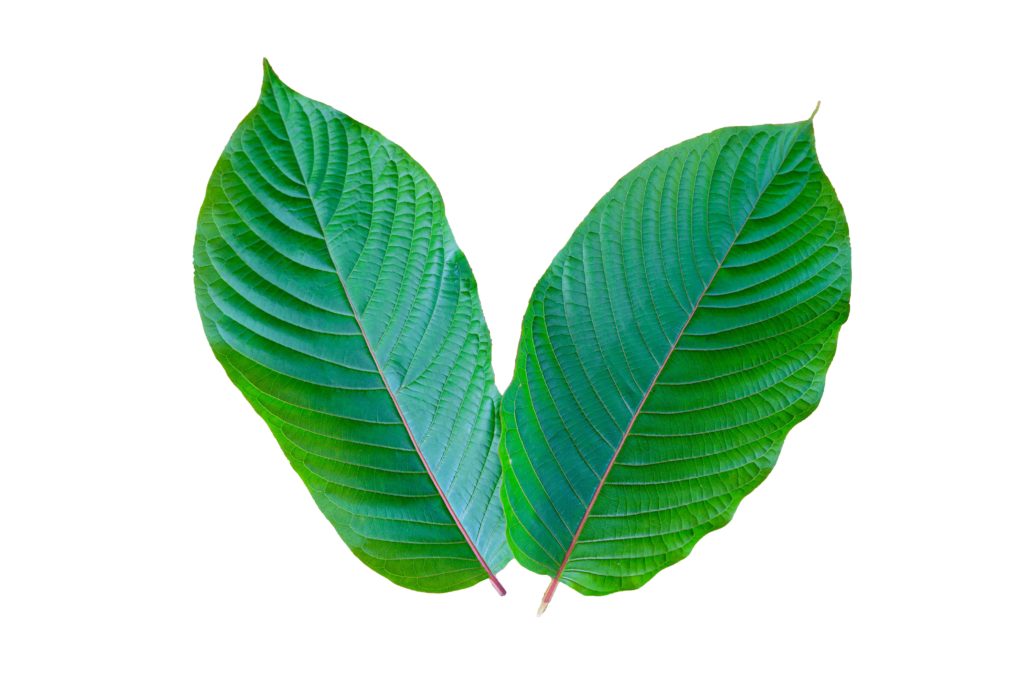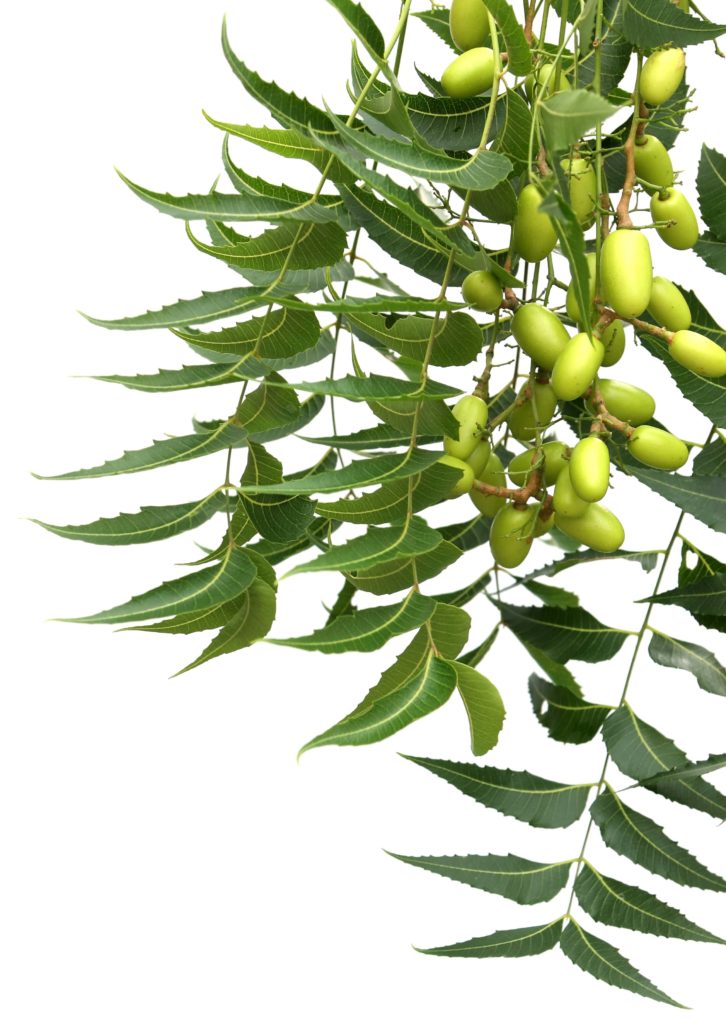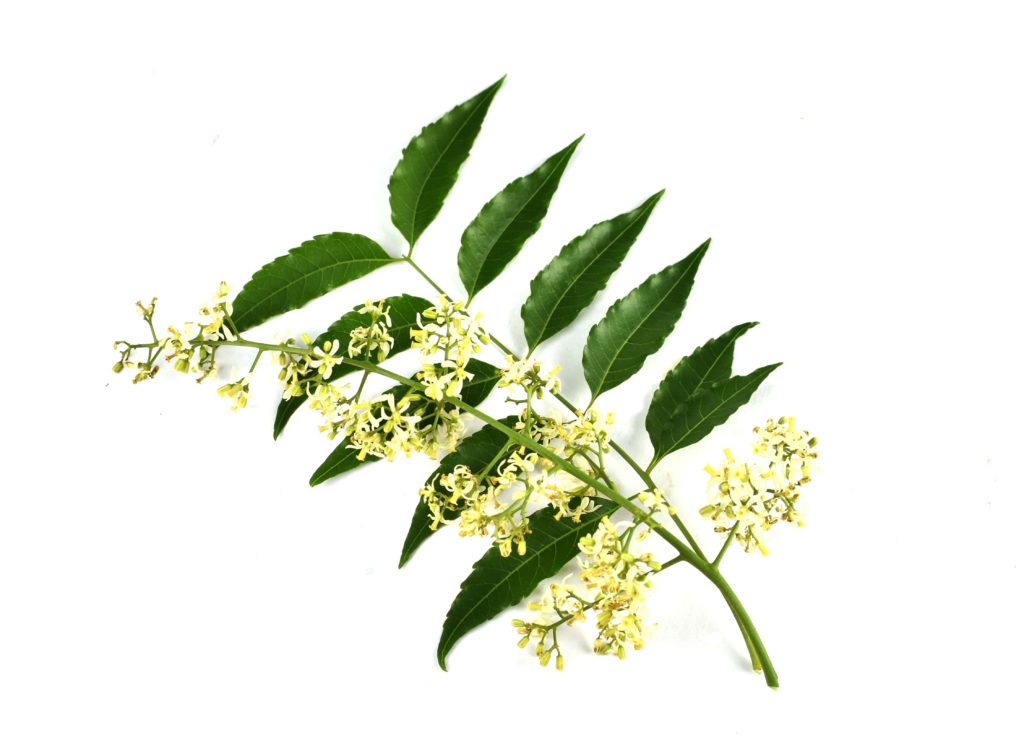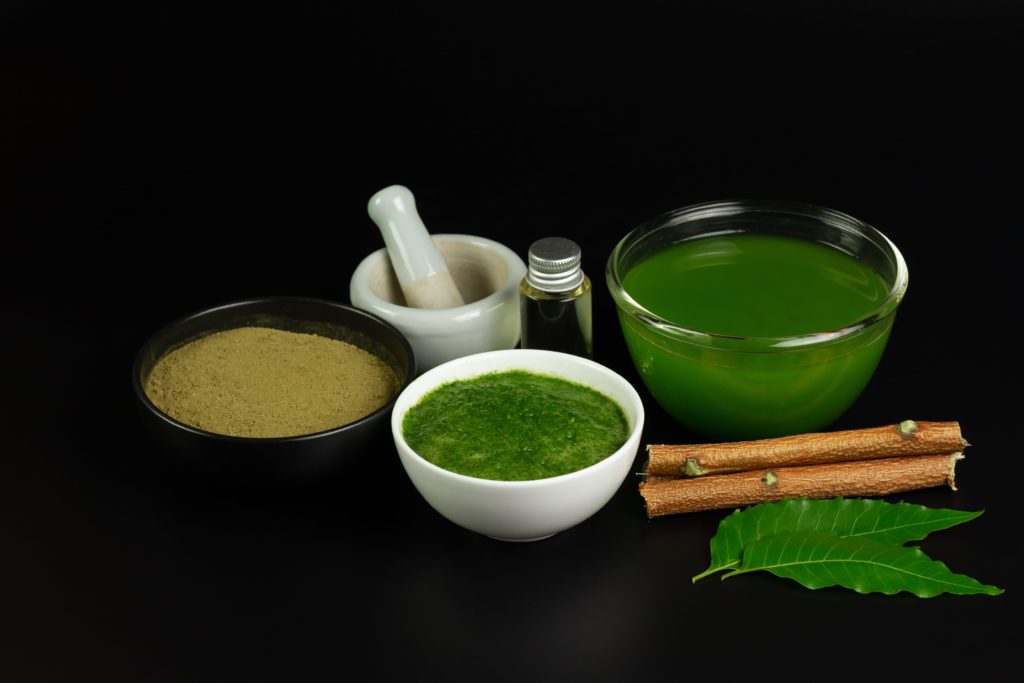The humble Neem tree is highly sought-after for its medicinal extract and other valuable properties. From being an excellent health tonic to having remarkable pesticidal properties, the uses of the Neem tree exceed those of most other trees. The extract of various parts of the Neem tree has medicinal properties that profoundly impact human health. Let us learn why the Neem tree extract deserves to be known as the Elixir of life.
Before we embark on a quest to know the Neem tree better, let us get to know its botanical details.

The Botany Of Neem
Azadirecta indica, a member of the botanical family Meliaceae, is the name by which botanists refer to the Neem tree. The Neem tree bears a nondescript appearance and resembles any of the numerous trees that commonly grow in your backyard or along the roads. The tree is well-built and grows to a height of 15-20 meters. The Neem trunk is robust, surrounded by a thick bark, and bears abundant leaves without sprawling a lot. Nimba, Arishtha, Veppa, Margosa, and Kohomba are some of the vernacular names of Neem.

The twigs of neem trees bear small, lush-green leaves with toothed endings. Neem flowers are small and white, while the fruit is fleshy, sweet, and yellow-colored. It is a contrast that the Neem fruit should be laden with fruit pulp when its leaves are famed for their strong and bitter taste. Almost all parts of the Neem tree yield an extract laden with medicinal properties. However, the Neem leaf is the most commonly used part of the tree in medicinal preparations.

The Neem tree is resilient and grows in the most challenging terrain laden with rocky soil. The Indian sub-continent, dry areas of Southern Asia, the Caribbean region, South America, and parts of the African continent have suitable weather conditions for the growth of the Neem tree.
How Neem Enhances Your Yoga Practice
Herbal medicines and Yoga have been closely associated since ancient times. Yogis, sadhus, and learned sages used herbs in various forms to assist their Yoga practice and ensure spiritual well-being. (CLICK here to learn about the herbs that complement your Yoga practice)
Neem has several properties that make it suitable for daily Yoga practice. Neem extract contains alkaloids that make it a potent anti-oxidant. Consuming a healthy amount of anti-oxidants is immensely beneficial for preserving the structural integrity of your body cells. Anti-oxidants effectively delay natural aging and keep your health robust for longer. One of the unique features of Yoga is that its practice is likely to enhance your longevity by slowing aging. Combining the anti-oxidant properties of Neem with the anti-aging effects of Yoga is a great way to retain your youth for a relatively long time.

Neem is a great cleanser and thoroughly detoxifies your mind and body. The Ashtanga of Yoga asserts the importance of a pure mind and soul and a healthy body while practicing Yoga. (READ our blog on the Ashtanga)
A healthy dose of Neem extract will allow you to cleanse your entire being and prepare yourself better for your Yoga session.
Neem has several other medical properties, many enhancing your Yoga routine. Let us get to know more about the fascinating Neem tree.
Medicinal Properties Of Neem
Neem has been used for its medicinal properties for ages. The simple-appearing Neem tree is also held in high regard by Ayurvedic science. The Charaka Samhita, one of the most significant Ayurvedic texts ever, also mentions the utility of Neem in balancing the doshas. (KNOW more about the doshas)
The book describes the Neem tree as ‘Sarva Rogi Nirvani,’ which means medicine that cures all ailments. True to its title, Neem acts on almost every physiological system of the human body. Let us get to know some of the critical medicinal properties of the Neem tree. The prominent active compounds found in the Neem extract are Azadirachtin, nimbolide, quercetin, beta-sitosterol, and salannin. Let us get to know more about their action on various human organs.

- Potent Anti-infective Agent
Neem has strong anti-bacterial and anti-fungal properties. Neem paste, powder, and oil are effective in treating skin infections of bacterial and fungal origin. Capsules and tablets medicated with neem extract work wonders to treat internal infections when consumed orally. Neem is also known to purify the blood and may be used as a supplement to treat debilitating infectious conditions like tuberculosis, typhoid, and malaria.
- Immunity Booster
Immunity is your body’s power to keep you from falling ill. Consuming Neem leaves enhances your immune system functions. Neem’s properties to purify blood and cure infections are essential as an immunity booster.
- Strong Anti-Oxidant
An anti-oxidant is a compound or chemical capable of preventing oxidation of your body cells, thereby delaying aging. The anti-oxidant effects of Neem extract avoid the spread of degenerative disorders. Neem extract may nurture the growth of healthy cells and rejuvenate body tissues afflicted with cancer.
- Digestive Tonic
Neem leaves extract rich in compounds that prevent the accumulation of excess acids within the stomach. Neem is an excellent remedy for sluggish digestion, heartburn, and acid reflux disease. Neem-based powders, capsules, and syrups enhance metabolism and promote healthy weight loss.
KNOW how Yoga improves your digestive health.
- Cardiac Health Modifier
As discussed previously, Neem is an excellent blood purifier and yields minimal side effects. Neem extract contains alkaloids that improve your blood circulation and also increase the oxygen intake of your blood. Neem leaves produce a section rich in vasodilators, which cause blood vessels to relax and reduce blood pressure. Having a healthy range of blood pressure is crucial to maintain an active cardiac system.
- Skin Health Monitor
There is no shortage of skin-care and cosmetic products loaded with neem extracts. Neem has skin-purifying properties, which allow the elimination of dead skin cells. Neem also promotes wound healing, reduction of acne, and erases blemishes without leaving behind any marks or scars.
Words can fall short of describing the incredible medicinal properties of Neem. You can use raw Neem leaves in their natural form to avail most of their therapeutic benefits. Consuming 2-3 tender Neem leaves daily for good health is safe. The Neem extract has a distinct bitter taste but yields positive results on your overall well-being.
Religious And Cultural Importance Of Neem
The association between man and nature dates back to as early as the creation of Mother Earth. Pre-historic people lived and established their community among nature. Trees, herbs, and shrubs have always contributed significantly to humankind’s health, cultural development, and even religious faith to a great extent. The Neem tree is immensely beneficial in promoting good health and well-being. Neem also finds importance in various cultural practices and traditions of the Hindu religion.
The Neem tree is considered to be a manifestation of Goddesses Durga and Kali, who are worshipped for their powers against evil forces. Goddess Shitala, revered for her cooling effect on human well-being, is believed to reside in the Neem tree. People often plant Neem trees in their courtyard to ward off evil energies and retain a peaceful environment in their families. According to one legend, Lord Indra, the Hindu King of all Gods, saved the holy nectar that Lord Shiva churned out from the ocean during a battle with all the demons from Hell.
LEARN more about the powerful deity, Lord Shiva.
The nectar was accidentally spilled on a Neem tree during the war. Since then, the Neem tree has been considered a curer of all diseases or the Sarva Roga Nirvani. Lord Surya, the Hindu Sun God, took refuge in a Neem tree during one of His fabled battles with the demons from Hell. Therefore, a custom prevails among Hindus that the one who plants three Neem trees in their life will find a place in the Sun God’s kingdom after death.
The Neem tree is also associated with funeral rituals among the Hindus. People attending cremation rituals of their deceased loved ones chew Neem leaves to ward off any evil spirits that may eye them. Neem extract is used to cover any wounds on the dead person’s body. This is a way to prevent the spread of any illnesses or pollutants during cremation rituals.
Folks residing in the Southern Indian States of Andhra Pradesh and Karnataka usher in their new year in March or April by eating Neem leaves or flowers mixed with jaggery. People residing in the Western Indian state of Maharashtra follow a similar custom on the same day by welcoming a new year by drinking Neem juice and eating jaggery. The contrasting tastes of Neem and jaggery symbolize the bitter-sweet moments that make life memorable. West Bengal and Tamil Nadu are the other Indian States where people worship the Neem tree during festivities.
The Neem tree is essential in our lives due to its immense beneficial properties. The Neem is genuinely the bitter Elixir that gives us a sweet life!
READ our blogs to learn more about other herbs and trees and their vital properties.







